AMD's Sempron 3300+: 90nm Budget Computing
by Anand Lal Shimpi on April 18, 2005 2:10 AM EST- Posted in
- CPUs
Workstation Applications
SPECviewperf 8
For our next set of professional application benchmarks, we turn to SPECviewperf 8. SPECviewperf is a collection of application traces taken from some of the most popular professional applications, and compiled together in a single set of benchmarks used to estimate performance in the various applications that the benchmark is used to model. With version 8, SPEC has significantly improved the quality of the benchmark, making it even more of a real world indicator of performance.
We have included SPEC's official description of each one of the 8 tests in the suite.
Not too surprising is the strong performance of the Sempron here; the chip's on-die memory controller ensures very good performance in all of the SPECviewperf tests.
3dsmax Viewset (3dsmax-03)
"The 3dsmax-03 viewset was created from traces of the graphics workload generated by 3ds max 3.1. To ensure a common comparison point, the OpenGL plug-in driver from Discreet was used during tracing.
The models for this viewset came from the SPECapc 3ds max 3.1 benchmark. Each model was measured with two different lighting models to reflect a range of potential 3ds max users. The high-complexity model uses five to seven positional lights as defined by the SPECapc benchmark and reflects how a high-end user would work with 3ds max. The medium-complexity lighting models use two positional lights, a more common lighting environment.
The viewset is based on a trace of the running application and includes all the state changes found during normal 3ds max operation. Immediate-mode OpenGL calls are used to transfer data to the graphics subsystem."
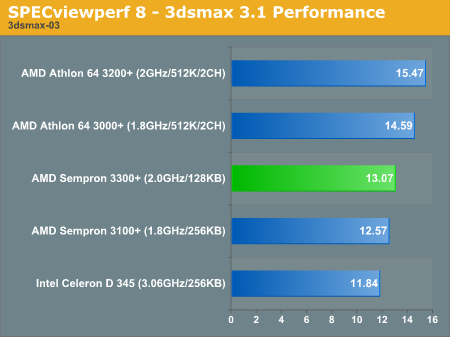
CATIA Viewset (catia-01)
"The catia-01 viewset was created from traces of the graphics workload generated by the CATIATM V5R12 application from Dassault Systems.
Three models are measured using various modes in CATIA. Phil Harris of LionHeart Solutions, developer of CATBench2003, supplied SPEC/GPC with the models used to measure the CATIA application. The models are courtesy of CATBench2003 and CATIA Community.
The car model contains more than two million points. SPECviewperf replicates the geometry represented by the smaller engine block and submarine models to increase complexity and decrease frame rates. After replication, these models contain 1.2 million vertices (engine block) and 1.8 million vertices (submarine).
State changes as made by the application are included throughout the rendering of the model, including matrix, material, light and line-stipple changes. All state changes are derived from a trace of the running application. The state changes put considerably more stress on graphics subsystems than the simple geometry dumps found in older SPECviewperf viewsets.
Mirroring the application, draw arrays are used for some tests and immediate mode used for others."
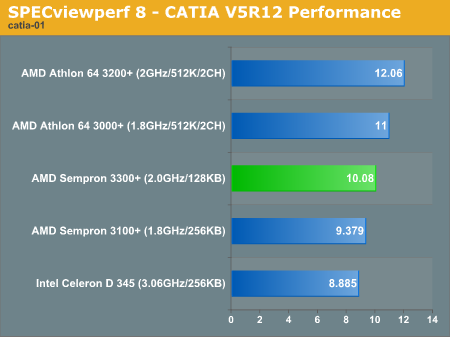
Lightscape Viewset (light-07)
"The light-07 viewset was created from traces of the graphics workload generated by the Lightscape Visualization System from Discreet Logic. Lightscape combines proprietary radiosity algorithms with a physically based lighting interface.
The most significant feature of Lightscape is its ability to simulate global illumination effects accurately by precalculating the diffuse energy distribution in an environment and storing the lighting distribution as part of the 3D model. The resulting lighting "mesh" can then be rapidly displayed."
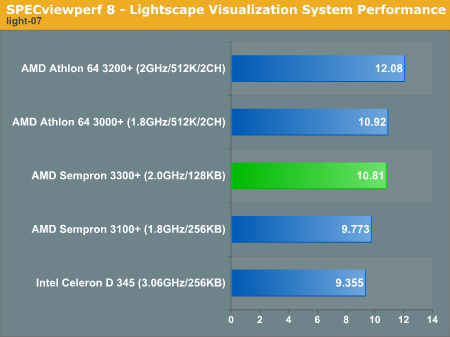
Maya Viewset (maya-01)
"The maya-01 viewset was created from traces of the graphics workload generated by the Maya V5 application from Alias.
The models used in the tests were contributed by artists at NVIDIA. Various modes in the Maya application are measured.
State changes as made by the application are included throughout the rendering of the model, including matrix, material, light and line-stipple changes. All state changes are derived from a trace of the running application. The state changes put considerably more stress on graphics subsystems than the simple geometry dumps found in older viewsets.
As in the Maya V5 application, array element is used to transfer data through the OpenGL API."
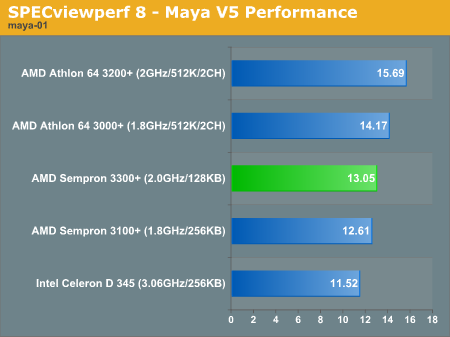
Pro/ENGINEER (proe-03)
"The proe-03 viewset was created from traces of the graphics workload generated by the Pro/ENGINEER 2001TM application from PTC.
Two models and three rendering modes are measured during the test. PTC contributed the models to SPEC for use in measurement of the Pro/ENGINEER application. The first of the models, the PTC World Car, represents a large-model workload composed of 3.9 to 5.9 million vertices. This model is measured in shaded, hidden-line removal, and wireframe modes. The wireframe workloads are measured both in normal and antialiased mode. The second model is a copier. It is a medium-sized model made up of 485,000 to 1.6 million vertices. Shaded and hidden-line-removal modes were measured for this model.
This viewset includes state changes as made by the application throughout the rendering of the model, including matrix, material, light and line-stipple changes. The PTC World Car shaded frames include more than 100MB of state and vertex information per frame. All state changes are derived from a trace of the running application. The state changes put considerably more stress on graphics subsystems than the simple geometry dumps found in older viewsets.
Mirroring the application, draw arrays are used for the shaded tests and immediate mode is used for the wireframe. The gradient background used by the Pro/E application is also included to better model the application workload."
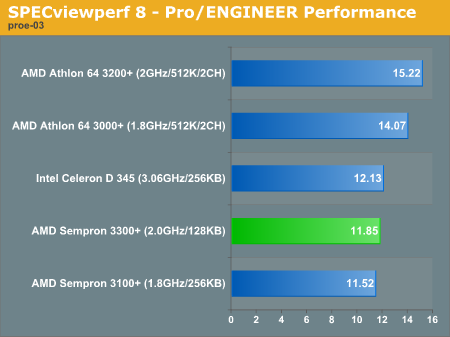
SolidWorks Viewset (sw-01)
"The sw-01 viewset was created from traces of the graphics workload generated by the Solidworks 2004 application from Dassault Systemes.
The model and workloads used were contributed by Solidworks as part of the SPECapc for SolidWorks 2004 benchmark.
State changes as made by the application are included throughout the rendering of the model, including matrix, material, light and line-stipple changes. All state changes are derived from a trace of the running application. The state changes put considerably more stress on graphics subsystems than the simple geometry dumps found in older viewsets.
Mirroring the application, draw arrays are used for some tests and immediate mode used for others."

Unigraphics (ugs-04)
"The ugs-04 viewset was created from traces of the graphics workload generated by Unigraphics V17.
The engine model used was taken from the SPECapc for Unigraphics V17 application benchmark. Three rendering modes are measured -- shaded, shaded with transparency, and wireframe. The wireframe workloads are measured both in normal and anti-alised mode. All tests are repeated twice, rotating once in the center of the screen and then moving about the frame to measure clipping performance.
The viewset is based on a trace of the running application and includes all the state changes found during normal Unigraphics operation. As with the application, OpenGL display lists are used to transfer data to the graphics subsystem. Thousands of display lists of varying sizes go into generating each frame of the model.
To increase model size and complexity, SPECviewperf 8.0 replicates the model two times more than the previous ugs-03 test."
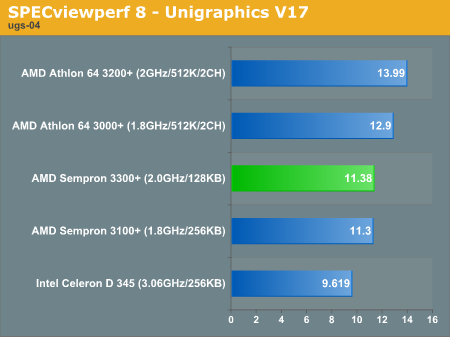










53 Comments
View All Comments
coldpower27 - Monday, April 18, 2005 - link
Maybe this is a way for AMD to get rid of "sucky" Venices. Though at 127US pricing, it's value is questionable over getting the Athlon 64 2800+.Illissius - Monday, April 18, 2005 - link
s/half the memory controllers/half the channels of memory/Illissius - Monday, April 18, 2005 - link
Are we looking at the same graphs? There were quite a lot where the 3300+ significantly outperformed the 3100+ (granted, also a few where they were identical, but very few where the 3100+ was faster).Which begs the question: wtf has AMD done to these things' memory controller? In many tests it ran dead even with or even outperformed the A64 3200+, with half the memory controllers and a fourth the cache (note: no, I didn't miss eg. the gaming benches where it rather sucked, but it's very surprising for it to give that kind of performance *anywhere*). At the same time, from every benchmark I've seen, Venices (Venii? :D) are only very slightly faster than Newcastles/Winchesters... strange.
paulsiu - Monday, April 18, 2005 - link
With a reduce cache, the 3300 did not seemed like a good deal especially if it barely beats the 3100. Why not just get a 3100 or overclock it. Better yet, get a A64 2800+.Once you hit a Sempron 3100+, their value becomes highly questionable because an A64 only cost a little bit more. The problem is that AMD appears to be discontinueing all A64 for the 754 socket with the exception of mobile A64. Few Mb manufacturer support mobiles directly.
AtaStrumf - Monday, April 18, 2005 - link
AT only got 2,4 GHz with increased voltage, XBIT Labs only got 2,3 GHz; damn these are some bad 90 nm chips. WTF is AMD up to? Venice chips did 2,7 GHz easy.As soon as get my hand on some $$$ I'm switching to S939, PCIe and a nice Venice chip. With dual core desktop Hammers not likely to appear before 2006, this will be the only game in town for the remainder of 2005 That is of course unless Pentium D tickles your fancy.
As for X800XT distorting the gaming value CPU picture, I think this is something worth thinking about. Maybe you should include a test with a 6600GT, just to see if a more expensive CPU, coupled with a value graphics card actually makes any difference.
Anand Lal Shimpi - Monday, April 18, 2005 - link
The 2.4GHz overclock was the most reasonable air-cooled overclock we could obtain. Regardless of how hard we tried, 2.50GHz was not possible with our chip.Take care,
Anand
Calin - Monday, April 18, 2005 - link
One big disadvantage of the Socket 754 Sempron would be the reduced memory bandwidth for an hypothetical "onboard video" solution. This is the main reason why I would like a dual channel Sempron that would cost much less than an Athlon 64. For now Sempron on Socket 754 (even with the lower price of the mainboards) is not a good choice in many regardsoverclockingoodness - Monday, April 18, 2005 - link
#14: Do you think AnandTech really have time for max overclocking experiements with phase cooling and stock cooling? It's all a waste. Besides, even though AT is an enthusiast site, they have more than enough projects to tackle than some enthuisiast sites who keep posting their maximum overclocks on the net. There are far too many forums and sites for that.And yeah, enough with the conspiracy theories. It is starting to become a regular thing in comments section of every article. People always find a way to doubt AT.
#13: I disagree. Imagine if they used 6600GT for the CPUs and almost all CPUs scored identical. This would mean that the GPU is the bottleneck. AT's goal is to remove the potential bottleneck. I am sure some people would come in and whine about the incorrect results due to GPU limitations. Although you will not get the same performance as AT did, at least it shows the product's strenghts/weeknesses. :)
knitecrow - Monday, April 18, 2005 - link
Considering the price of an sempron 3100+ to be $113 @ newegg and the price of a athlon64 2800+ to be $120; I see absolutely no reason to get a sempron!!!!!!!!!!!Visual - Monday, April 18, 2005 - link
wooo, bobsmith1492, that's the one!and its on top of the news section too... how didn't i notice it... i must be going nuts.
well sorry about that.
THEY SPY ON US WITH RAY! Wait, I must have my tinfoil hat here somewhere....
P.S. and yeah, it'd be good to see the actual overclock max of the chip, with a mem divider and lowered htt multi and all. at various voltages. with stock and phase-change cooling. :p